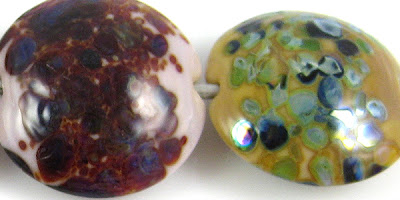1 - Plain, 2 - Plain (reduced), 3 - w/ Silver Leaf, 4 - w/ Silver Leaf (reduced & encased), 5 - w/ TerraNova2 Frit, 6 - w/ Silver Glass Frit (reduced), 7 - w/ Tuxedo, 8 - w/ Copper Green, 9 - w/ Opal Yellow, 10 - w/ Ivory, 11 - w/ White
I have tested quite a few of the Lauscha Milky Way colours now, and this is one of my favourites. It has some magic in it somewhere!
Lauscha Dusty Lilac is a pinkish lavender colour, and although it is probably translucent in thin layers, it was not possible for me to keep the translucency of this glass while working it. It is reactive with silver, it does fun things with both Copper Green and Opal Yellow and it is a pretty colour all by itself. I'm a sucker for these purply pinks though. Seashell Swirl and Vetrofond Pink #3 are the other two pink glasses that I can't get enough of.
When silver leaf is melted into the surface of Dusty Lilac, the silver turns a golden colour and sits on top of the surface of the glass in a very definite gold swath with winking silver sparkles in it. It also fumes the colour of the Dusty Lilac to a shade somewhere in the triangulation of brown, yellow and orange.
When the silver is reduced and encased, it looks less yellow -- there is just a faint tinge of yellow in the encased silver. Where the silver touches the Dusty Lilac around its edges, an ethereal blue halo has developed. Also in this bead, the silvered, abused and encased Dusty Lilac looks very vibrantly pink and purple instead of like its natural lavender-pink self.
Dusty Lilac and silver glass are friendly with one another. On the right, I got some colour out of my TerraNova 2, and the striking silver glass frit has not discoloured the bead at all. In a real bead where time has been taken to properly strike the TN2 I feel sure the results would be better.
In the bead on the right, it is interesting how the Dusty Lilac has fumed yellow underneath the reducing silver glass frit, and the frit has done some interesting things on top of it as well, seaparting in places and developing a darker yellow outline.
There is no reaction between Tuxedo and Dusty Lilac, and both colours make nice, even stringer dots and lines on top of each other.
When Dusty Lilac is used on top of Copper Green, it develops a light turquoise outline and seems to keep the Copper Green from doing that army green sheen thing it so loves to do. However, when you use the Copper Green on top of Dusty Lilac, a very bizarre reaction is evident. The Copper Green sort of lazily separates so that it looks teal in the middle and brown around the edges and then it develops an additional whitish outline around the brown and teal. Nifty.
Dusty Lilac spreads and thins out on top of Opal Yellow, which is interesting because Opal Yellow is the softer glass and is the one out of these two that I would expect to spread. On top of Dusty Lilac, Opal Yellow separates into three distinct 'phases' - a translucent lavender line in the middle of the dots and stringer lines surrounded by a more normal shade for opal yellow, and then surrounded by a yellowish brown outline. You can see in the middle of this bead how the Dusty Lilac has fumed the Opal Yellow to a brownish yellow colour as well.
Dusty Lilac is weird and spready on Ivory, too. In this case it seems even odder because it seems to float on top of the Ivory and some of the Ivory colour rises up around it to help our eyes see that illusion. On top of Dusty Lilac, Ivory separates such that a translucent line and dot is visible in the middle of the stringer lines and dots.
And, with Peace, Dusty Lilac reacts similarly to how it reacts with Ivory only much less dramatically. It does not have the same floaty quality when used on top of Peace.
A fun bead with Dusty Lilac:








No comments:
Post a Comment